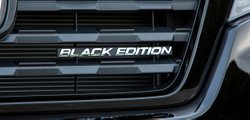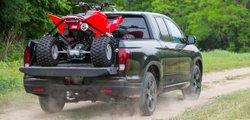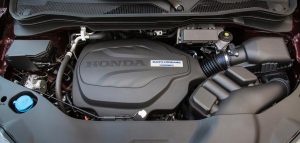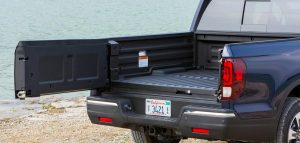The Unconventional Pickup Truck
After taking more than a two-year time out to rethink things, Honda brought its redone Ridgeline pickup truck back for the 2017 model year. I have done a 180 in regards to the Ridgeline, and now accept it as a pickup even though it is unconventional.
First introduced in late 2005, the Ridgeline, with its unibody construction and flying-buttress C-pillar and an all-wheel drive system that operated mostly in front-wheel drive, didn’t sell as well as Honda had hoped. Honda stopped production in 2014.
I have deep pickup roots and have owned several over the years, mostly Fords, including a 1939 model and a 1952 F1 in which I swaped the flathead V-8 for a Chryselr Hemi. To me, the word pickup meant body-on-frame construction, a separate cab and cargo bed, live rear axle, north-to-south mounted engine, and, for off-road versions, a part-time four-wheel drive system that runs mostly in rear-wheel drive.
That’s the reason why, in my 2006 review, I called the Ridgeline a “pretend pickup.†It didn’t have any of the attributes of my pickup definition plus, it looked totally out of place with its flying buttress C-pillars.
Times Change; Pickups Change
As times change, so has my view of pickups. While the Ridgeline still doesn’t fit my pickup description, it has the towing, hauling and off-road capabilities that fits the needs of many pickup buyers. In the end, isn’t that what being a truck is all about?

During the Ridgeline’s hiatus, Honda discovered that 66 percent of Toyota’s Tacoma trucks sold in the large California market were two-wheel drive models, and that 63 percent of their own Pilot crossover SUVs were front-wheel drive. That led to adding a front-drive variant to the 2017 truck, which has an EPA estimated fuel economy of 19 mpg city/26 highway/22 combined–the same as the 2017 Chevrolet Colorado and GMC Canyon equipped with smaller four-cylinder engines. Subtract 1 mpg for each of the economy estimates for the all-wheel-drive Ridgeline.
There’s a list of seven trim levels, each with more features then the last. If there’s a specific option that you want, then you get all that comes with that package, whether you want them or not. The trim levels, starting with the base model to the top end, are RT, RTS, Sport, RTL, RTL-T, RTL-E, and Black Edition. Pricing starts at $26,475 for the RT front-wheel drive and works its way up to $42,870 for Black Edition all-wheel drive.
Hey, Now It Looks Like A Real Pickup
The 2017 Ridgeline remains a five-passenger, four-door crew cab style truck, but now has a true pickup silhouette with a 90 degree transition between the cab and cargo box. That should appeal to those, like me, who found the previous model design disconcerting. Gone are the buttresses between the cab and the bed which, in addition to improving the look, also improves side access to the forward area of the truck’s cargo bed.
From the rear doors forward, the new Ridgeline is mostly a Honda Pilot. The rounded front fascia with a large chrome strip and headlights are the same shape as those on the Pilot. Where it differs from the Pilot is in the lower front fascia, where the Ridgeline has more black body cladding with fog lights integrated into it. On the backside, the new model has a conservative design that could probably belong to any other midsize truck if you removed the Honda badging.

Looking to the rear, the Ridgeline’s bed is where the magic really happens. For 2017, Honda extended the bed’s length by four inches compared to the previous generation’s five-foot length, and widened it by five and a half inches. The composite dent-resistant bed is now wide enough to accommodate 4×8 building materials, the only midsize truck that can do so.
But wait, there’s more. A dual action tailgate drops down like a conventional pickup or swings open from the side for easy access to a locking under-floor cargo well with a drain plug. It can be used to store four sets of golf clubs or filled with ice and used as a mobile cooler. The bed has LED cargo lighting, eight standard tie-down points and can be had with a 400-watt AC inverter at the upper trim levels. That can provide enough juice to power a 60-inch flatscreen TV and more. The Ridgeline’s piéce de résistance is the industry’s first truck bed audio system (in its top RTL-E and Black Edition models). With the in-bed trunk inverter, cooler and audio system, the Ridgeline is a self-contained tailgating machine.
The 2017 Ridgeline edition continues with a car-like unibody construction. It shares its platform and chassis design with the new Pilot SUV, but about 50 percent of the four-wheel independent suspension components and the truck’s subframe have been beefed up, lightened or strengthened for the Ridgeline to better accommodate the conditions and demands of a pickup truck. While the unibody design renders superior ride and handling, it’s at the expense of some traditional truck capabilities. The 5,000-pound towing capacity falls shy of its more robust competitors, while its light-duty all-wheel drive system and 7.3 inches of ground clearance limit its off-road prowess. On the other hand, Ridgeline’s 1,584-pound payload is class leading.
Interior More SUV than Pickup

Like the exterior, the inside of the new Ridgeline plays off the 2017 Honda Pilot SUV. The cabin boasts more inside room than competitors with 109 cubic feet of breathing split between its two rows. The interior is fitted with upscale materials that wouldn’t be out of place in a comfortable sedan with soft-touch materials everywhere. Its seats are large and comfortable and the dashboard and control panel layouts are attractive and ergonomic. Gone is the traditional column shifter in favor of a console-mounted unit. A new center console offers up a seemingly unending combination of useful storage spaces.
The rear seating area is large enough to comfortably accommodate three. The rear seats flip up and away making room for tall items like a bicycle or a flatscreen TV. When that rear seat is folded down, there’s still enough room beneath it to hide a golf bag or a pair of large backpacks.
All 2017 Ridgelines come well-equipped, with standard rearview camera, rear parking sensors, cruise control, a color LCD display screen in the dashboard, Bluetooth hands-free phone connectivity, audio with at least 200 watts of power and seven speakers. Our AWD Black ED test driver was loaded with every feature available on the Ridgeline, including LED headlamps, moon roof, leather interior, heated front seats and steering wheel, eight-inch touch screen with navigation, premium 540-watt audio system with Apple CarPlay, Android Auto and HondaLink smartphone apps.
Pickups aren’t typically known for their high-tech features, but our Black Edition stepped up to the plate with the full suite of Honda Sensing driver aid technologies. These included adaptive cruise control, lane departure warning with lane-keeping assisted steering, and a collision-mitigation auto-braking system with pedestrian detection. Rear cross-traffic alert and automatic high-beam assist headlamps added further driver-aid technologies.
A clever feature I almost missed is the tire fill assist. This feature works with the tire pressure monitoring system to provide an audible chirp and flash of the parking lights when any tire being filled reaches the correct pressure.
A Week with the Ridgeline
During our week with the 2017 Ridgeline, we soaked up 443 miles on a wide variety of roads. The mixed bag included city streets, two-lane highways, interstates and U.S. Forest Service trails. A rare snow storm iced up local roads a bit for a half day, and one stint saw 365 pounds of dirt in the cargo bed.

Immediately noticeable was the Ridgeline’s excellent forward visibility, which I attributed to the truck’s hood and fender design. Knowing that the driver aid technology helped to see what I couldn’t added to the feeling of safe and comfortable driving. Both the adaptive cruise control and blind spot monitor were welcomed.
The reengineered 280 horsepower 3.5-liter V-6—borrowed from the Pilot— was a smooth and generally quiet powerplant. With 262 pounds-feet of torque, acceleration was quite brisk, and the truck’s 0 to 60 mph time of a tad under seven seconds is tops in the midsize class, according to Honda. The six-speed automatic transmission delivered precise shifts, and kicked down without fuss when quick acceleration was needed.
Driving on city streets, the all-independent suspension combined with the unibody construction was more crossover SUV-like rather than a conventional pickup. Pot holes, railroad tracks and speed bumps were nothing to fear. The hop when going over a bump without a load experienced when driving a truck with a solid rear axle was nonexistent.
While in town driving is far more comfortable than the competition, where the Ridgeline really shows its stuff is on the highway. It is the closest to mimicking a car you will find. It smoothly and quietly ate up worn tracks in the road and expansion joints as if they weren’t there. It went where I pointed with few corrections on the steering wheel, and when more acceleration was needed to pass, there was never a lack of power. As we said back in the day, “This is a smooth moto’ scooter.â€
While this was going on, the engine was quite frugal with gasoline. The V-6 is equipped with Honda’s Variable Cylinder Management, which allows the engine to operate on three cylinders under light load. The transition from six to three cylinders and back was totally seamless. Our reward was 27 mpg on an interstate drive of 167 miles where we spent much of the time at 75 mph.
Pickup trucks aren’t canyon carvers, but on a 23-mile two-lane back country stretch filled with tight off-camber S curves, the Black Edition Ridgeline was, for a pickup, fun to drive. Braking was secure when heading into a turn and the truck glided through with the aid of the all-wheel drive system’s torque vectoring. This electronic wonder actively sends power to the outside or inside wheels when cornering to reduce the turning radius.

As for the AWD system, there’s a “Snow†mode that performed admirably on the ice-covered streets during our brief winter storm. There’s also a “Mud†mode that we put to good use during a few hours on several little-used Forest Service Trails. The AWD system wasn’t designed to tag along with a group of serious off-roaders in 4WD Chevy Colorados Toyota Tacomas or Nissan Frontiers. But, for the average user, the Ridgeline is capable of getting you where you want to go and back, if you use common sense.
As for fuel economy, well, I had a smile on my face when I gave the Ridgeline back to Honda. After those 443 miles, we averaged 21.7 mpg in a pickup truck with a V-6 engine and AWD.
The Pickup Truck for You?
You’ve probably guessed by now that I have done a 180 in regards to the Ridgeline, and now accept it as a pickup even though it is unconventional. However, it may not be the pickup for you.
Do you need to tow more the 5,000 pounds? Will you join friends in serious off-road trips? Is the Ridgline’s pricing out of your reach? If you answered yes to any of these questions, don’t even bother dropping by a Honda dealership. Instead, check out the midsize offerings from Chevrolet, GMC, Nissan and Toyota. If you can wait a couple years, Ford is bringing back its Ranger.
But, if you want a dependable and comfortable daily driver with truck features, it’s hard to beat the Ridgeline. It will fit the needs of many pickup customers and meet the demands of most who don’t require severe-duty capability. Yet there is no midsize pickup equal on the market when it comes to on-road manners and expanded utility in the bed.
Don’t just take my word on it, take it for a test drive and find out for yourself.
Related Stories You Might Enjoy:
News: Dedicated Hybrid Coming to Honda’s 2018 Truck Lineup
Road Test: 2016 Chevrolet Colorado Diesel
News: Pickups Pick Up MPG
Road Test: 2016 Ram 1500 EcoDiesel
Disclosure:
Clean Fleet Report is loaned free test vehicles from automakers to evaluate, typically for a week at a time. Our road tests are based on this one-week drive of a new vehicle. Because of this we don’t address issues such as long-term reliability or total cost of ownership. In addition we are often invited to manufacturer events highlighting new vehicles or technology. As part of these events we may be offered free transportation, lodging or meals. We do our best to present our unvarnished evaluations of vehicles and news irrespective of these inducements.
Our focus is on vehicles that offer the best fuel economy in their class. We also feature those that are among the top mpg vehicles in their class. In addition, we aim to offer reviews and news on advanced technology and the alternative fuel vehicle market. We welcome any feedback from vehicle owners and are dedicated to providing a forum for alternative viewpoints. Please let us know your views at publisher@cleanfleetreport.com.

5 thoughts on “Road Test: 2017 Honda Ridgeline”